At 6,189 m, Island Peak (Imja Tse) is one of Nepal’s most popular trekking peaks. Here’s a recommended itinerary, up-to-date climbing logistics, and a personal account from my trip.
Located in the Chhuhung Valley within the Khumbu (Everest) Region of Nepal, Island Peak is often considered an excellent entry-level trekking peak for those interested in Himalayan high-altitude mountaineering. However, it still provides some exposure to semi-technical elements of climbing.
The name “Island Peak” comes from its appearance as an isolated island rising from the icy glacial valley, encircled by towering Himalayan mountains such as Lhotse (8,516 m), Nuptse (7,861 m), Baruntse (7,162 m), and Ama Dablam (6,812 m).
After climbing Island Peak I’ve written this helpful guide to planning expedition logistics with an itinerary covering Kathmandu to Island Peak Base Camp, the summit day, and return.

Climbing Island Peak's Summit Ridge
Before I get into the complete guide to planning preparation, logistics, and gear– here's what you can expect at the summit ridge!
Island Peak: Overview & Things to Know
Island Peak (Imja Tse) is an excellent first step into the world of Himalayan high-altitude mountaineering. This climb allows those with little to no previous mountaineering experience the challenge of climbing a 6,000-meter peak in the Everest region and breathtaking views of some of the world's highest mountains.
- Climbing Island Peak involves trekking through sections of the Everest Base Camp route for roughly one week towards Island Peak base camp.
- From this camp, it's a single, physically challenging 10-14 hour summit day, requiring the use of mountaineering equipment including a Jumar (ascender), mountaineering harness, belay device, and mountaineering crampons. For many climbers, this will be the first time using any of this equipment.
Imja Tse was first summited in 1953 by members of the British Mount Everest Expedition a preparation peak before climbing Mount Everest. These days, it is still a common training peak before climbing taller peaks like Ama Dablam, Baruntse, Manaslu, or Mount Everest.

Can I climb Island Peak without a guide?
Even if you are an experienced mountaineer, climbing Island Peak is almost impossible considering Nepal's current rules surrounding trekking and peak climbing with guides. At the very least you will need to arrage a Sherpa guide to climb Island Peak.
Can you see Mount Everest from the summit of Island Peak?
No, while Mount Everest is very close to Island Peak, its summit is blocked by the shoulders of the towering Lhotse. However, you will get great views of Mount Everest on the trek to Island Peak Base Camp.
Is Island Peak dangerous?
Climbing any 6,000-meter peak in the Himalayas poses some risk of accident, fall, avalanche, or altitude sickness (acute mountain sickness). However, this is a very popular trekking peak and as you are climbing with a reputable guide or trekking company, all safety measures should be accounted for.
How difficult is it to climb Island Peak?
While considered a trekking peak, climbing Island Peak does pose some semi-technical elements. Generally, the expedition-style climb is given the Alpine PD+ grade under the Alpine Grading System. This means it is a little difficult and involves some semi-technical multi-pitch climbing and glacier traverses.
Imja Tse is considered a good peak for novice climbers. Summiting Imja Tse is not a very technical climb but does pose a physically demanding challenge involving a 7-9 day trek to base camp, followed by a long, 10-14 hour ascent of over 1,100 vertical meters up a multi-pitch route through rock, ice, and glacier.
The most difficult segment is at the final headwall before the Island Peak summit. This final 200-meter near-vertical section varies in difficulty depending on the season and amount of compacted snow (Névé). The headwall ranges from a messy mix of rock scrambling and ice climbing (what we faced), to a steep frozen jumar slope.
Additionally, while the summit of Island Peak sits at a lower altitude, reaching it is more difficult than climbing Mera Peak (6,476 m), Nepal's highest trekking peak.
What boots for Island Peak?
You will need at least a pair of 6,000-meter-rated mountaineering boots to climb Imja Tse. Popular options include the Scarpa Phantom 6000 and the La Sportiva G2 Evo. I've listed more options and gear requirements for the climb above.
How much does it cost to climb Island Peak Nepal?
There are many costs involved with this expedition, including trekking permits and insurance, as well as meals, transport, and tea house lodging on the route to Island Peak base camp. Most expedition companies charge in the vicinity of $1,800 to $4500 USD.
What's better, Island Peak or Mera Peak?
Island Peak (6,189 m), while at a lower elevation, is a more challenging climb. It offers climbers the opportunity to experience real ice and rock climbing. On the other hand, Mera Peak (6,476 m)is more of a long trek involving no technical climbing skills. However, the high camp on Mera Peak is amazing.
What about Island Peak vs Lobuche East?
Lobuche East (6,119 m) is very similar to Island Peak in terms of elevation and hard work. Depending on seasonal conditions Lobuche East may be very slightly more technical than Island Peak.
Has anybody ever died on Island Peak?
Imja Tse has a very low death rate and after doing some research I have found that there have been very few, if any, reported deaths in recent years. However, people have died on this mountain, mostly from HACE and other altitude-related issues.
Can you climb Island Peak on the Everest Base camp trek?
Yes, Island Peak base camp is only a short, 2-hour trek from Chhukung. Therefore, it is possible to complete a 2-day detour from Dingboche on the EBC route via Chhukung to climb Island Peak. You may wish to climb over the Kongma La Pass afterward, which would place you in Lobuche, just 2-days from Everest Base Camp via Gorak Shep. Chhukung & the Kongma La is part of the Khumbu Three High Passes Trek.
How high is Island Peak?
The height at the summit of Island Peak is 6,189 meters or 20,305 feet. Its prominence is officially 475 m (1,558 ft). Island Peak Base Camp, also called Pareshaya Gyab, sits at an altitude of 5,087 meters (16,690 ft), meaning the summit day requires a vertical push of over 1,100 meters (3608 ft).
How should I prepare for the climb?
The summit day involves a 10-14 hours push of over 1,100 vertical meters at high altitudes. Therefore the most difficult part, in my opinion, is the physical exertion. It's important to be mentally strong with good physical fitness for this climb.
Previous experience at high altitudes and with rock and ice climbing would be useful. However, novice climbers can do this climb, since extensive experience and advanced technical skills are not necessary.
When is the best season to climb?
The best time to climb Island Peak follows the standard Himalayan trekking seasons of March to May (before the monsoon), and from October to December (after the monsoon). I climbed during the month of April, which falls in one of the best seasons for climbing. We faced predictable clear, bluebird mornings and foggy late afternoons.
It is not possible to climb Island Peak during the monsoon season, when the region experiences bad weather and heavy rain. During the winter months climbing in Sagarmatha National Park can get very cold.

Permits & Costs to Climb Island Peak
The expedition costs for Island Peak range from $1,800-$4,500. However, I recommend that you thoroughly check the inclusions when booking. The cheaper expeditions often leave you paying for extras en route to and at base camp, including meals, gear hire, porter fees, Sherpa insurances, etc.
While the reputable tour and expedition companies will handle the fees, permits, and logistics costs for you, here's a breakdown of what these are in USD and NPR:
- Island Peak Climbing Permit (from NMA): $250 in Spring or $125 in Autumn
- Sagarmatha National Park Fee: 3,000 Nepali Rupees
- Lukla Local Government Fee: 2,000 Nepali Rupees
- Climbing Gear Hire in Chhukung: $100-$200
- Return flights to Lukla: $300-$390 (to/from KTM or Ramechhap)
- Summit Bonus Per Sherpa (tip): Minimum $300
In general, expect to pay about $4,000 in total for the entire trip from Kathmandu (including all meals, permits, transport, lodging, tips, etc).

Booking the Right Island Peak Expedition: My Experience
I booked my Island Peak expedition with Epic Expeditions. This comprised an 18-day expedition package from Kathmandu Airport to Kathmandu. Additionally, it included all meals, lodging, Lukla flights, transport, permits, porters, and local Nepali and Sherpa guides.
Epic is a small company known for their awesome adventure experiences in far-flung corners of the world. If you're looking to climb Island Peak with fun, like-minded people, this company is kind of known for attracting a great crowd (think group tours for people that don't do group tours).
I've been on many organised trips and expeditions over the past 6 years of full-time travel and this was hands-down one of the best I've been on. I certainly made some friends for life on this trip.

Trekking & Climbing Insurance for Island Peak
It goes without saying but if you are climbing a 6,000-meter peak in Nepal, you're going to want to have insurance with helicopter evacuation cover as a minimum.
Unfortunately, most regular regular travel insurances will void coverage the moment you step over 4,500 meters above sea level. For an Island Peak expedition, you'll want to look into the options for trekking travel insurance.
Generally, I've been using a Global Rescue membership. This is a very safe bet in Nepal and doesn't have any altitude caps. I've also used the HR insurance as an add-on to the Garmin inReach mini satellite communicator, but the price has increased recently.

Staying in Kathmandu Before Trekking
The trekking and tourist hub in Kathmandu is called Thamel. This is where you will find all of the best trekking shops, hostels, restaurants, bars, and hotels in Kathmandu.
If you're planning a trek in the Himalayas, you'll want to find a hotel or hostel that allows you to leave your luggage there until you return. Read my guide to Kathmandu's best hotels, or take a pick from the three best accommodation options below that offer this service.

1. Aloft Kathmandu Luxury
Overlooking the city from the heart of Thamel, this is "the place" where climbers including myself stay before big expeditions. It's a luxury pick with epic amenities like a gym, rooftop pool, and an EPIC buffet breakfast.

2. Flock Hostel Budget
Best backpacker hostel in Thamel with very clean dorms with curtains & private rooms with excellent views. Amazing on-site cafe & restaurant serving delicious coffees & international meals.

3. Nirvana Boutique Hotel Mid-Range
A peaceful boutique hotel to escape the hustle & bustle. Best mid-range pick with a 9.7/10 rating on Booking.com.
Typical Island Peak Itinerary From Lukla
Island Peak is located near the village of Chhukung in the Solo Khumbu region of Nepal, within the Sagarmatha National Park (a UNESCO World Heritage Site). This is colloquially known as the Everest Region.
- The Island Peak itinerary follows the famous Everest Base Camp trek route, beginning in the mountain village of Lukla.
- Online, you will find varying itineraries but generally, these will involve a 7-9 day trek to Island Peak base camp, followed by a single-day summit push, and a trek back to Lukla via the same route.
Here's what an 18-day expedition looked like with Epic Backpacker Tours. As with any expedition, this changed a little when we were on the ground since we had an excellent weather window and went for the summit push earlier (read on for a full account of my trip with more photos).
| Day | Description | Altitude (m) |
|---|---|---|
| 1 | Arrive in Kathmandu International Airport | - |
| 2 | Tour of Kathmandu City | - |
| 3 | Early morning flight to Lukla & Trek to Phakding | 2,610 |
| 4 | Trek from Phakding to Namche Bazaar | 3,440 |
| 5 | Acclimatization Day in Namche Bazaar (Trek to Khumjung & Everest View Hotel) | 3,440 |
| 6 | Trek from Namche Bazaar to Tengboche (Tyangboche) | 3,870 |
| 7 | Trek from Tengboche to Dingboche | 4,360 |
| 8 | Trek from Dingboche to Chhukung | 4,730 |
| 9 | Acclimatization Day in Chhukung (Climb Chhukung Ri) | 5,546 |
| 10 | Trek from Chhukung to Island Peak Base Camp | 5,070 |
| 11 | Rest Day & Climbing Training at Island Peak Base Camp | 5,070 |
| 12 & 13 | Summit Island Peak or Contingency Day depending on weather conditions | 6,189 |
| 14 | Trek from Island Peak Base Camp to Tengboche | 3,870 |
| 15 | Trek from Tengboche to Namche Bazaar | 3,440 |
| 16 | Trek from Namche Bazaar to Lukla | 2,610 |
| 17 | Early morning flight from Lukla to Ramechhap or Kathmandu | - |
| 18 | Departure | - |
Alternative: Helicopter From Kathmandu to Island Peak Base Camp
Climbers on an express expedition or those taking on the ascent of Island Peak in preparation for 7,000 or 8,000-meter ascents can also fly directly to Island Peak base camp from Kathmandu via helicopter.
Typically, this isn't recommended unless you are acclimatized since Island Peak base camp sits higher than 5,000 meters above sea level. The cost for this helicopter journey ranges from $1,500 to $2,500.
Day 1: Fly to Lukla & Trek to Phakding
- Hike Distance: 7.8 km
- Hike Time: 2.5-3 hours
- Elevation: 50 m ascent, 200 m descent
- Sleep Altitude: 2,610 m
As with most expeditions and trekking routes in the Nepalese Khumbu, the trek to Island Peak base camp begins at Lukla, the mountain airport runway and gateway to Sagarmatha National Park.

The Flight to Lukla
Lukla Airport (Tenzing-Hillary Airport) is notorious for being one of the world’s shortest and most dangerous runways. It was built in 1964 and named after Sir Edmund HIllary and Tenzing Norgay, the first climbers to summit Mount Everest.
Lukla is a very busy airport, accommodating dozens of flights per day.
To aid with congestion issues at Kathmandu International Airport, the Nepalese government has halted all flights from Kathmandu to Lukla in the peak trekking seasons of April and May, and September and October.
To make things simpler, if you’ve booked your Island Peak climb with Epic Backpacker Tours as I did, the flight will be arranged for you. This will be either from Kathmandu, or from the village of Ramechapp (roughly 5 hours via minivan from Kathmandu).
Either way, your goal should be to get on the first flight at 6 am to secure the highest chances of departure, since delays and consequential backlogs spanning multiple days are common in the peak seasons.
As our expedition was in late March, we had the privilege of flying from Kathmandu. So, after an early 4:45 departure from Aloft Hotel, we set off for the airport, where we managed to get on the first flight out from Kathmandu.

The Airport Village of Lukla
This was the third time I’d experienced the thrill of the notorious Lukla airport flight. Taking off, we were blessed with fine weather and clear views of the Himalayan peaks, with their shadowed foothills casting rays of light through the hazy valley below.
Following a short, 30-minute flight, we stepped off the plane, chugged a coffee at the nearby airport tea house, and set off for the first Sherpa village of Phakding.
Passing through the town of Lukla filled me with warm memories from previous trips to this region. It seems every year the town is expanding, with new modern cafes, international restaurants, and lodges popping up on the main street.

Following the Everest Base Camp Route
This first section follows the main Everest trail to base camp. So you can expect to share the trail with many other trekkers, expedition teams, porters, and beasts of burden.
Additionally, this well-maintained trekking highway is the primary artery connecting Lukla to Namche Bazaar, the capital of the Sherpa world and the starting point of countless other Khumbu trekking itineraries. These include the Three Passes Trek and Gokyo Trek, as well as the route to major Khumbu trekking and climbing peaks like Mount Everest, Lhotse, Lobuche East, and Ama Dablam.

Route to Phakding
Walking through the northern end of Lukla, we eventually passed the Pasang Lhamo memorial gate. This is dedicated to the first Nepali woman to summit Everest.

Immediately after, the trail drops and follows the base of the ridge before dropping down to the eastern banks of the Dudh Kosi.
The trail on this first day is remarkably well maintained, with a long section of paved rocks making for a smooth and enjoyable walk. Some segments offer great views of the distant mountains, including Kusum Kangru (6,367 m). Others are lightly forested, with segments passing large mani stones.

A highlight for me was the first suspension bridge crossing before Thadokoshi over the Thado Kosi Khola.
This day was also very easy, with very little elevation gain as we passed the colorful Sherpa villages of Cheplung, Thadokoshi, Ghat, and Chhuthawa.
After just two and a half hours of enjoyable trekking, we arrived in the village of Phakding. Our guides directed us to Trekkers Lodge, where we sipped tea and enjoyed the Himalayan sun.

Side Trip to Pema Choling Gomba (Buddhist Monastery)
After lunch, we took a short side trip to the 350-year-old monastery on the hillside of Pharak.
This involves a short but slightly steep 30-minute detour from Phakding by heading north, crossing the suspension bridge, and following the trail left after the lodge. This trail leads past the small Sherpa village of Rimijung.


The Gomba was undeniably beautiful, and we were fortunate to witness a tantric chanting ceremony before departing back down to Phakding. Alternatively, there is also the option to continue to the Thaktul Gomba just a little further on as well.



After returning to Phakding, we spent a night playing cards in the lodge before settling in for an early night.


Day 2: Phakding to Namche Bazaar Trek
- Hike Distance: 12 km
- Hike Time: 5-6 hours
- Elevation: 1,000 m ascent, 100 m descent
- Sleep Altitude: 3,440 m
The second day on our Island Peak itinerary travels from Phakding to the Sherpa capital of Namche Bazaar.

Phakding to Sagarmatha National Park Entrance
After a delicious breakfast and plenty of great French press coffee courtesy of Chris from the Epic Backpacker team, we continued north from Phakding. This section joins the trail following the Dudh Kosi Valley towards Namche Bazaar.
The first section features sections of light undulation, breaking in and out of tall pine forests to pass through a scatter of small villages including Zamfute, Toktok, and Benkar. These prayer flag-draped townlets often farm potatoes and cabbage among the tea houses and restaurants.



There are a couple of epic suspension bridges along the way, which make for some great photo opportunities.


After approximately 2.5 hours, we arrived at Monjo, where at the northern end we passed through the Sagarmatha National Park entrance gates.
Here, we met military guards who asked us about drones. We showed our trekking permits, and continued on, which Epic Backpacker Tours had already arranged for us in Kathmandu.
Trekking Tip: it is customary to only walk clockwise around the many mani stones and prayer wheels you’ll find along the trail. This is a Tibetan Buddhist tradition to ensure good luck on your passage.

Trek to Namche Bazaar
Entering Sagarmatha National Park is an amazing feeling and a moment that I cherish each time I visit the Khumbu. Immediately through the gates, the trail drops back down into the valley before another scenic suspension bridge crossing.

Just 5 minutes later, we arrived at a nice lunch spot by the river in Joralse. This is a good spot to take a quick rest and refuel since it is the last village before the big push in altitude to Namche Bazaar.


Immediately after lunch, we came across another suspension bridge before dropping down to the riverbank where the Bhote Kosi and Dudh Kosi intersect.

Looking up, this is where we got our first glimpse of the Edmund Hillary Bridge, the longest suspension bridge in this region, hanging hundreds of meters above the valley.

This bridge crossing is a true highlight on the push to Namche. It is over 140 meters long and rises over 124 meters above the Dodh Kosi!




Immediately after, the big climb begins. This features a series of switchbacks through the pine forests, climbing steeply. Along the way, there is a small viewpoint where you can see the first views of Mount Everest’s peak. However, on this day the cloud was already coming in, and we couldn't get a good glimpse.
Arriving in Namche was a welcoming sight. This is the capital of the Sherpa world, and a truly beautiful and strong village perched on the side of a mountain. This village is always expanding, with amazing lodges, decent cell signal, barista cafes, snooker bars, and even a barber salon.

We checked into the chalet-esque Bhodi lodge, where we enjoyed a complimentary hot shower before a delicious buff burger for dinner.

Day 3: Namche Bazaar Acclimatization Hikes
- Hike Distance: 11 km
- Hike Time: 5-6 hours
- Elevation: 650 m ascent, 650 m descent
- Sleep Altitude: 3,440 m
In preparation for climbing Island Peak, it’s crucial that we follow a regimented acclimatization protocol. Although it is an entry-level trekking peak, summiting a Himalayan mountain above 6,000 meters is no joke.
Therefore, the plan for day 3 was to hike up the famous Everest View Hotel, with a small side trip to the village of Khumjung to prepare our bodies for the higher elevations.

Trekking to Everest View Hotel
This hotel/cafe is a popular route for express trekkers looking to enter the Khumbu for direct views of some of the world's tallest peaks including Mount Everest, Lhotse, Nuptse, Ama Dablam, and Thamserku. On the trek from Namche Bazaar on a clear day like the one we had, we could see Kongde Ri, Kusum Kanguru, and Khumbila dominating the landscape.

The Everest View Hotel is very popular. In fact, many people even fly here directly from Kathmandu for the breakfast view of a lifetime.
For us, this hotel served as a smart and scenic side trip from Namche. We began by climbing the cobbled roads leading up from the Namche Gomba towards the Tyangboche trail. After reaching a large mani boulder, we took the shrubby trail left, leading up a steep hill, which eventually levels off around a small bluff for incredible views of Ama Dablam, Mount Everest, Lhotse, and Kusum Kanguru.
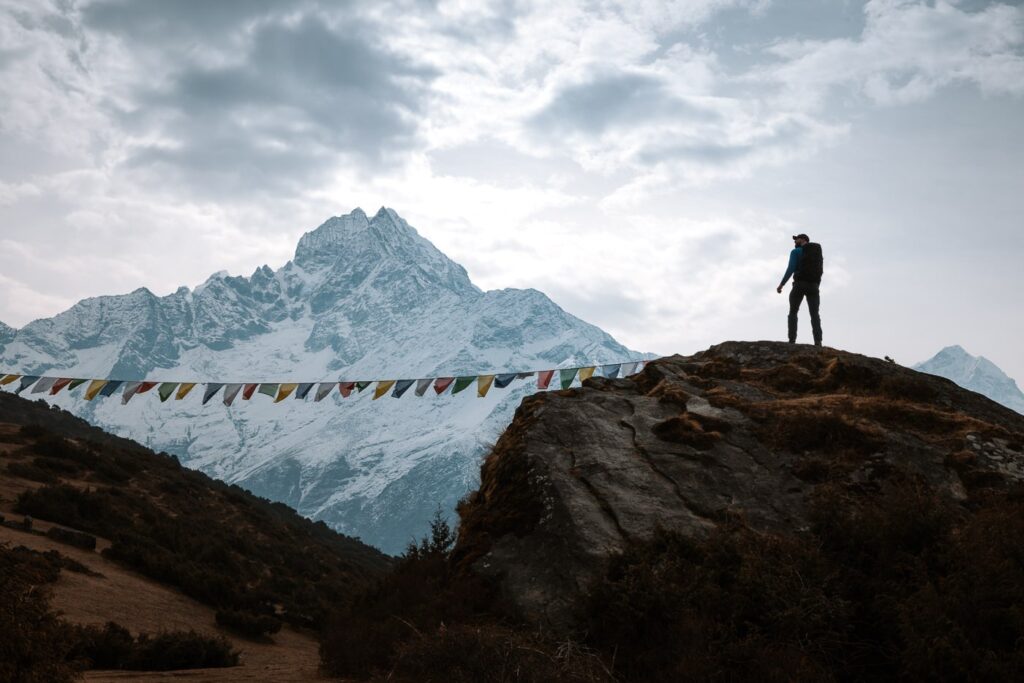




After approximately 2 hours we reached the Everest View Hotel, where we sat and enjoyed the Himalayan views for just under an hour with our puppy friend Momo.

Side Trip to Khumjung Village
Next, some of our group members split up and headed for the village of Khumjung (3,780 m), just a short 30-minute detour from the Everest View Hotel.
This village is famous for having the highest number of Everest summitters per capita, anywhere in the world. It’s also one of the largest villages in the Khumbu, with its vast potato fields scattered beneath the powerful Khumbila peak (5,761 m).

Khumjung is also known for the Khumjung Hillary School, a school built by Sir Edmund Hillary in 1960, and for having the longest mani walls in the Khumbu.
Khumjung feels a lot more like an authentic Sherpa town since it is typically left undisturbed by the hectic Khumbu trekking itineraries. We walked around the village, visiting the nearby monastery and enjoying a delicious serving of dal bhat before returning back to Namche via a looped trail passing the Namche monastery.

If you have more time, you can also hike to the village of Khunde from Khumjung, which I did back in 2019 on my first time visiting Namche Bazaar.




Day 4: Namche Bazaar to Tengboche (Tyangboche)
- Hike Distance: 10.6 km
- Hike Time: 5 hours
- Elevation: 800 m ascent, 350 m descent
- Sleep Altitude: 3,870 m
We awoke at Bhodi Lodge greeted by a snow-blanketed Namche, after a few inches of spring snow fell throughout the night.
By morning, the clouds had cleared, unveiling the towering peaks of Kusum Khangaru, Thamserku, and Khongde Ri surrounding the Sherpa capital.


The next day of this Island Peak itinerary again follows the typical Everest Base Camp trek by continuing on to Tengboche (also written as Tyangboche).
We climbed the steps of Namche, passing the trail to Everest View Hotel at the large mani boulder. Next, the trail entered into a magical snowy forest, before opening up and cutting down the side of a large ridge.


This ridge continues and at each spur, an even more magical view appeared in front of us. The Khumbu had offered us a clear, snow-swept morning, with excellent views of Thamserku, Ama Dablam, Lhotse, and Everest. On this day we had magical conditions which made for some of my favorite photos from the Island Peak trip.






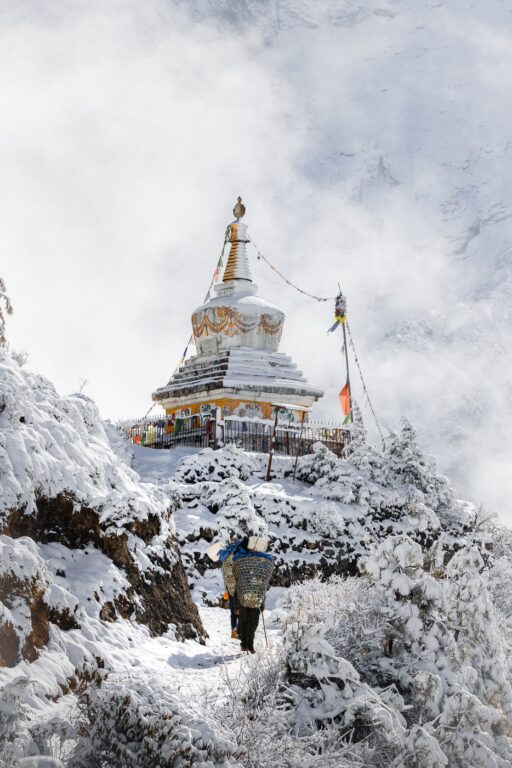
Soon, we arrived at the junction at Sanasa, whereby the trail splits to Gokyo and to Khumjung. The trail we followed to Tengboche cuts downhill towards the river, passing the small village of Lawichasa losing approximately 300 meters of elevation in the process.
Eventually, the trail levels off at the riverside village of Phunki Thenga, where we stopped to enjoy a delicious lunch before crossing yet another scenic suspension bridge. Immediately after, there is a small military checkpoint marking the beginning of the long, 600-meter ascent to Tengboche.


This is a big push uphill featuring a series of endless switchbacks. We took our time while appreciating the training it was providing for our attempt at climbing Island Peak.
Arriving at Tengboche
While Tengboche is a small village with only 5 lodges, it is home to the famous Tengboche Monastery (Tengboche Gomba) the largest of its kind in the Khumbu Region.

We checked in to the extremely well-run and fancy Tashi Delek lodge, which had espressos and warm apple pies available for us.
In the afternoon, we took a quick tour of the Gomba, before settling into the lodge and enjoying some time playing cards and drinking plenty of hot ginger lemon honey tea.

Day 5: Trekking From Tengboche to Dingboche
- Hike Distance: 11 lm
- Hike Time: 5-6 hours
- Elevation: 750 m ascent, 150 m descent
- Sleep Altitude: 4,360 m
On day 5 of our Island Peak itinerary, we woke up to pristine clear, blue sky conditions illuminating a fresh blanket of snow over Tengboche.

After taking some time to soak in the snowy sights of Ama Dablam, Tobuche, Lhotse, and Everest, we visited the Tyangboche Gomba, hoping for a chance to join a Purja ceremony to grant us safe passage in the mountains.
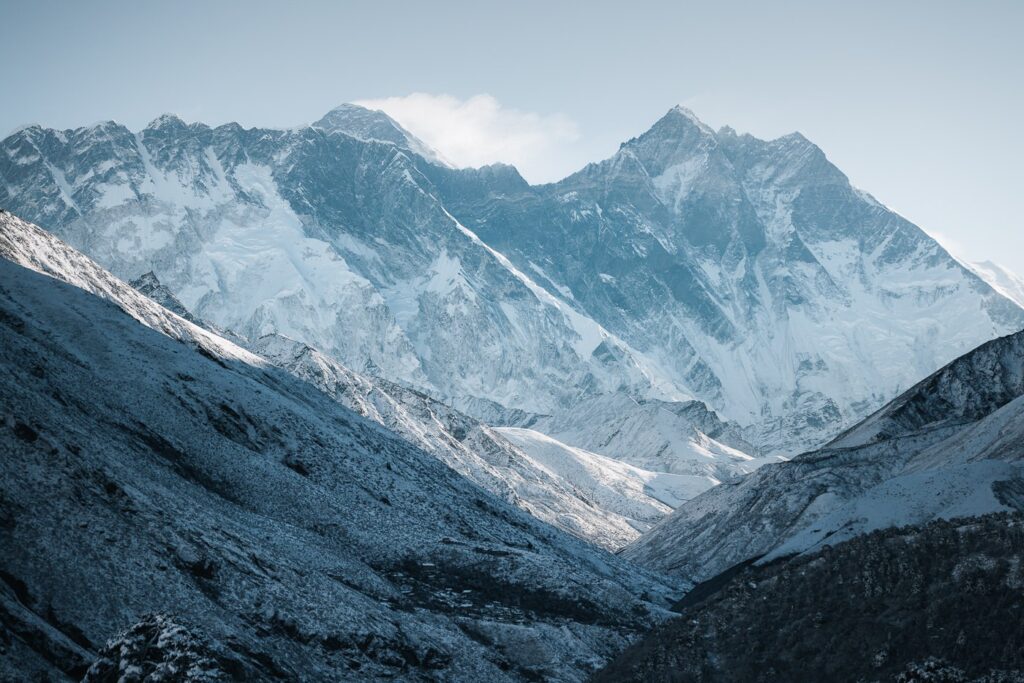



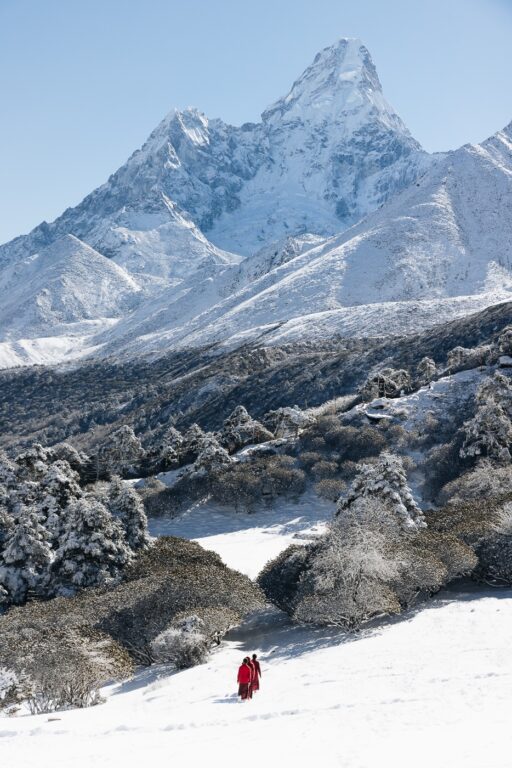
However, it seemed that the monks were instead practicing their morning mantras on this day.
After breakfast, we again set off through a mystical, snow-blanketed rhododendron forest, dropping slightly before reaching the village of Debuche, where I stayed last time I visited on the Three Passes trek.

Next, the trail passes the Debuche Nunnery, a small Buddhist site for women.
Soon after, we reached another amazing suspension bridge hanging over the Imja Khola. Next, the trail climbs, with amazing views of Ama Dablam. I captured some of my favorite shots of the Island Peak expedition on this section of the hike to base camp.





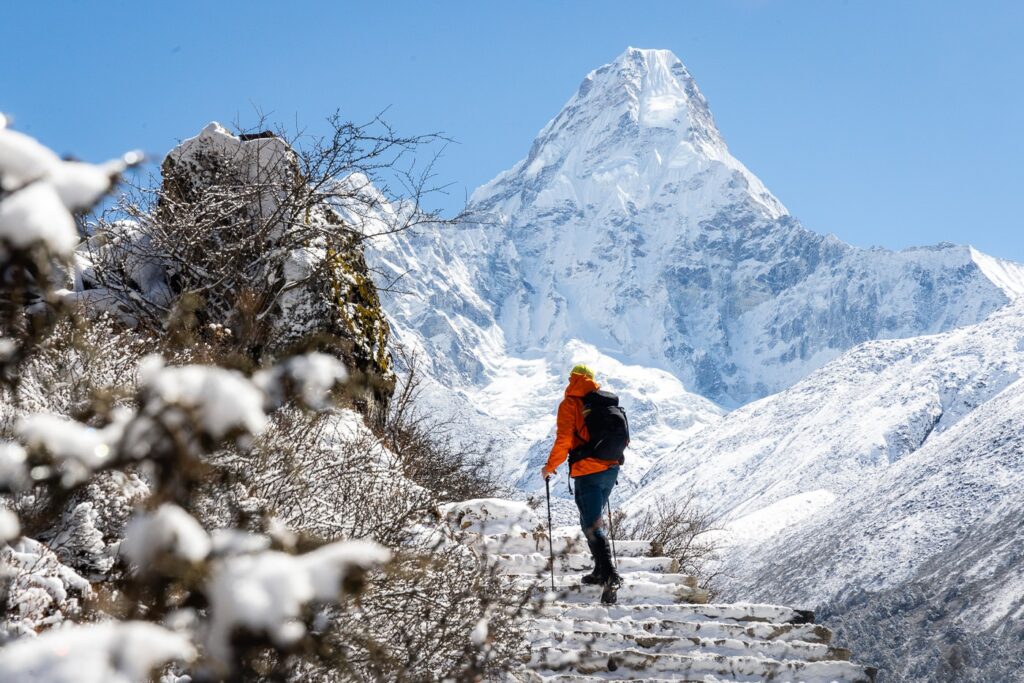




Trekking for another five hundred meters, we reached yet another amazing photo spot, where a beautiful white chortens crowns a small bluff directly beneath Ama Dablam.

Pangboche
The views continued to impress for the following segment to Pangboche village, offering us more amazing photo opportunities very close to Ama Dablam base camp. Arriving in Pangboche, we took the higher trail leading above the monastery, rounding the village and then dropping down to the lower trail towards Shomare, where we stopped for a delicious lunch.

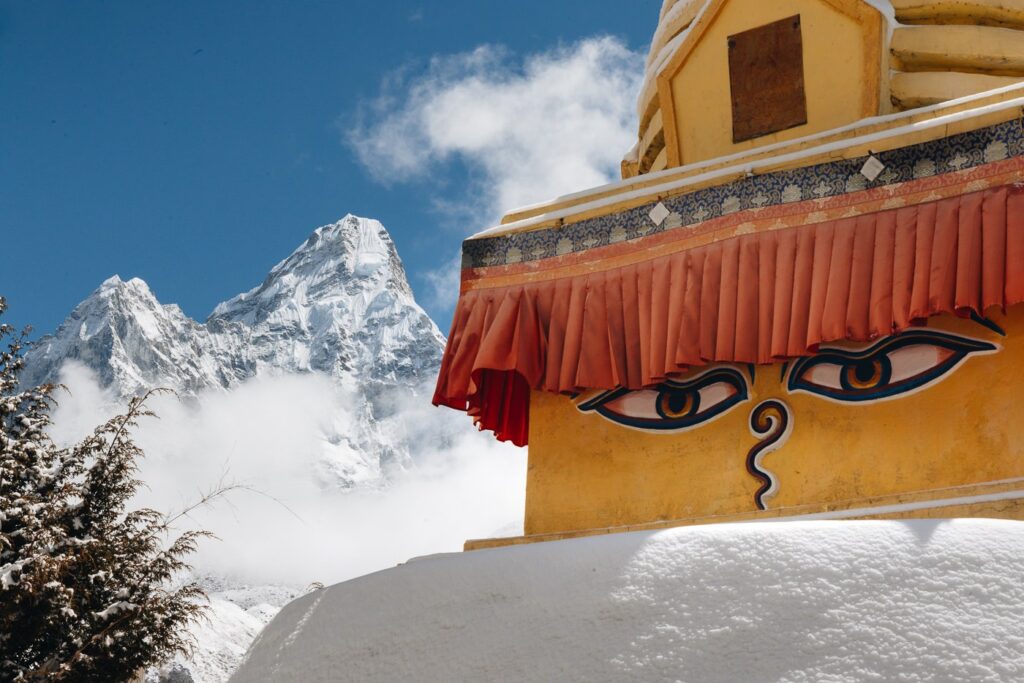


The final push towards Dingboche climbs up the Orsho plain, sprawled with large boulders across a wide knoll. Soon, we arrived at a crossroad, whereby we took the lower trail, dipping down to a steel bridge over the Imja Khola and climbing another 200 meters or so to Dingboche. The upper trail at this crossroad leads to Periche, another popular stop on the Everest Base Camp Trek.

Dingboche is quite a large village, overlooked by two golden-tipped white stupas. We stayed at the Good Luck Lodge, which had great facilities and an excellent dining hall.



Day 6: Trekking From Dingboche to Chhukung
- Hike Distance: 5 km
- Hike Time: 2-3 hours
- Elevation: 420 m ascent, 50 m descent
- Sleep Altitude: 4,730 m
Kicking off the sixth day of the hike to Island Peak base camp is the short but incredibly scenic hike to Chhukung.
Chukhung is the last village in the upper Imja Valley and the main port of call before departing for Island Peak base camp or the Kongma La Pass towards Lobuche.


Besides perhaps the trek from Lukla to Phakding, the stroll to this upper village is one of the easiest and most scenic of the trip so far. The Khumbu is widely considered one of the most beautiful regions of the Himalayas, and this path to the upper Imja Valley is one of the finest in the region.
The obvious trail picks up north of Dingboche and climbs steadily up the ancient moraine. On all sides, we had panoramic snow-capped mountain views of Cholatse, Taboche, and the almost unrecognizable north face of Ama Dablam.





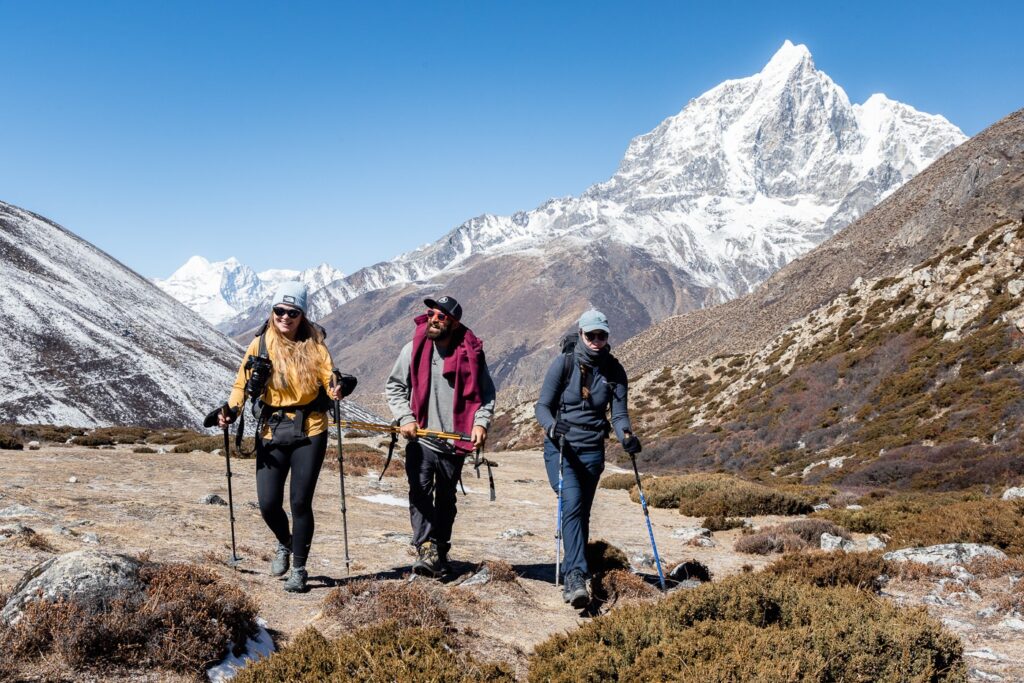
Waking up to clear, bluebird skies we also spotted our goal in the distance, Island Peak, isolated beneath the towering south face of Lhotse, with Peak 39 and Cho Polu, a holy peak framing the scene. As the trail progressed, we also spotted a glimpse of the mighty Makalu in the far distance.


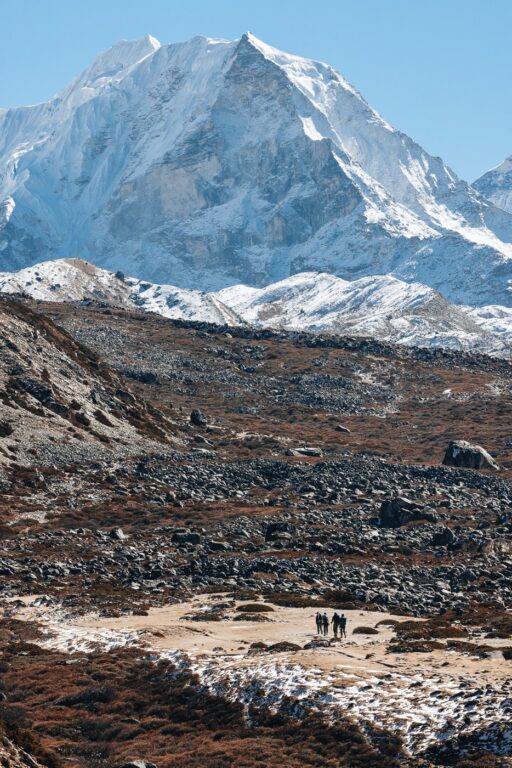
After roughly 1.5 hours we reached the isolated and seemingly abandoned tea house known as Bibre, where we took a quick rest before continuing on for the final 30-minute walk to Chhukung Village. We checked into the Chhukung Resort and enjoyed the warm sunroom.


There's also a great bakery and cafe in Chhukung (yes at 4,730 m), where we had ample time to drink espressos and eat cinnamon buns.
Day 7: Chhukung Ri & Island Peak Training Day
- Hike Distance: 5 km
- Hike Time: 5 hours
- Elevation: 680 m ascent, 680 m descent
- Sleep Altitude: 4,730 m
Today we enjoyed a rest day at Chhukung before departing for Island Peak base camp and subsequent summit attempt.

Climbing Chhukung Ri
There is the option on this day to take the acclimatization hike up to Chhukung Ri, a 5,546 m rocky peak behind the village. I’d climbed this before and knew I wanted to see the incredible views at sunrise. So, Noemi and I with headlamps on, set off at 4 am, walking to the northern end of Chhukung and followed the trail to the signpost indicating the way to Kongma La.


Soon, we crossed a small metal bridge over a frozen creek and continued up the worn trail to the top of Chhukung Ri. We faced windy conditions, and a narrow snowy ridge leading to the viewpoint on the left, marked by many rocky cairns.
The views during sunrise were incredible, offering a clear, panoramic vantage point of Ama Dablam, Island Peak, Baruntse, Makalu, Cholatse, and even the pyramid-like Pumori mountain in the Khumbu Valley.






We stayed at the peak for roughly an hour taking photos before making the climb back to the village. My watch only recorded 5,350 m of altitude, which makes me think that the official 5,546 m recording of Chhukung Ri must be the small rocky hill behind the left viewpoint.
However, we figured that the views were clearer and more unobstructed from this left summit.


Island Peak Skills Training Session
After a 4.5-hour return trip, we made it back to the Chhukung Resort Lodge for a delicious breakfast. Next, without much time to spare, we departed for the snowy moraine hillside near Chhukung for a skills training session.
For many in our small group, this was the first time they’d strapped on crampons or used a Jumar. Therefore, adequate training on how to use these tools was crucial before attempting to climb Island Peak.


Chris and Sohail from Epic fixed a rope on a steep section of the moraine and we each took turns jumaring up and abseiling down with our choice of belay device (I use a figure-eight).
This training session took roughly two hours. For the rest of the day, we enjoyed a long nap, a big serving of dal bhat, and another hot espresso and cinnamon roll at the nearby bakery before the big mission ahead.



Day 8: Trek to Island Peak Base Camp
- Hike Distance: 6.5 km
- Hike Time: 2 - 2.5 hours
- Elevation: 375 m ascent
- Sleep Altitude: 5,070 m
After two comfortable days at Chhukung, we packed our expedition duffels, leaving behind unnecessary items, and departed for the base camp of Island Peak.
The route follows a steady and gentle climb up the moraine toward the base of Island Peak. Having good weather, we had views of our mountain goal for the majority of the 2-hour short walk to camp.



The worn path to the base of Island Peak is easy to follow. Additionally, the views on offer from the top of the moraine looking back towards the Lhotse glacier below were incredible.
Arriving at base camp delivered mixed feelings of anticipation with a sprinkle of nerves. Initially, our itinerary planned for a rest day at Island Peak with contingency days. However, due to a perfect weather window, our lead climbing guide made the call that we'd depart for the Island Peak summit that very evening.
The camp was well organized and crewed by a team of 6 Sherpas. Our camp accommodations came in the form of large, comfortable expedition tents floored with thick, double mattresses. Our Epic Backpacker Tours team also had our own mess tent, where we enjoyed unlimited hot tea and delicious lunch and dinner.





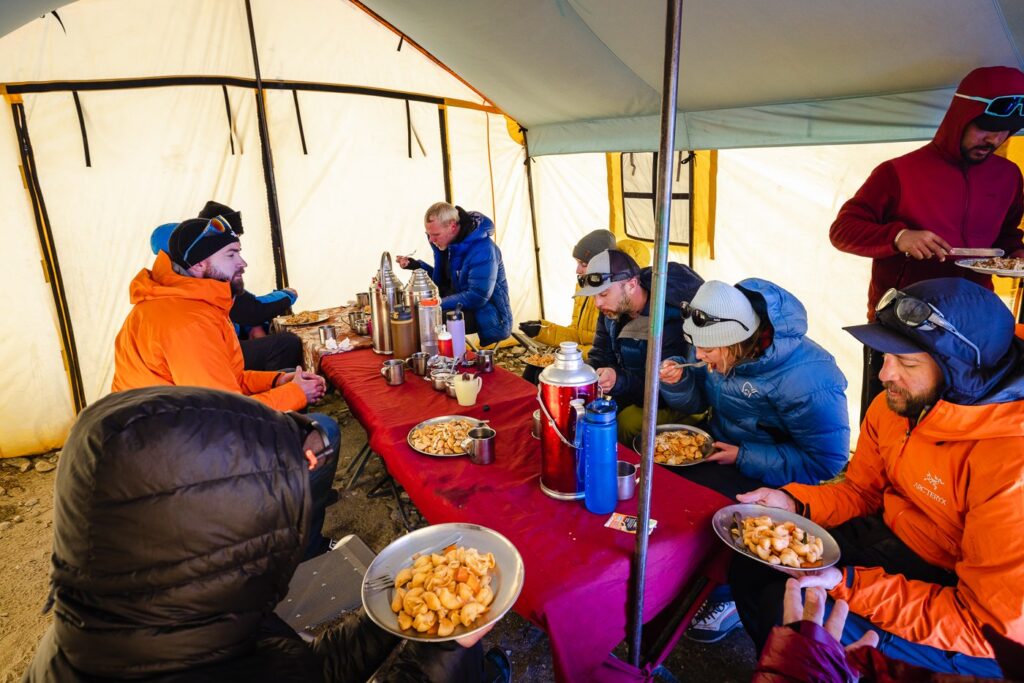
In preparation for the Island Peak summit push, we all underwent another short jumar and rappelling training session on a nearby hill. From the camp, we could also walk up the moraine behind us for amazing views of the (lake), which has largely replaced the melting Imja Glacier due to climate change.

Finally, to wrap up another great day, we said goodnight and settled into our expedition tents at 7:30 pm, preparing for a huge summit push beginning at 1 am for a very early start.


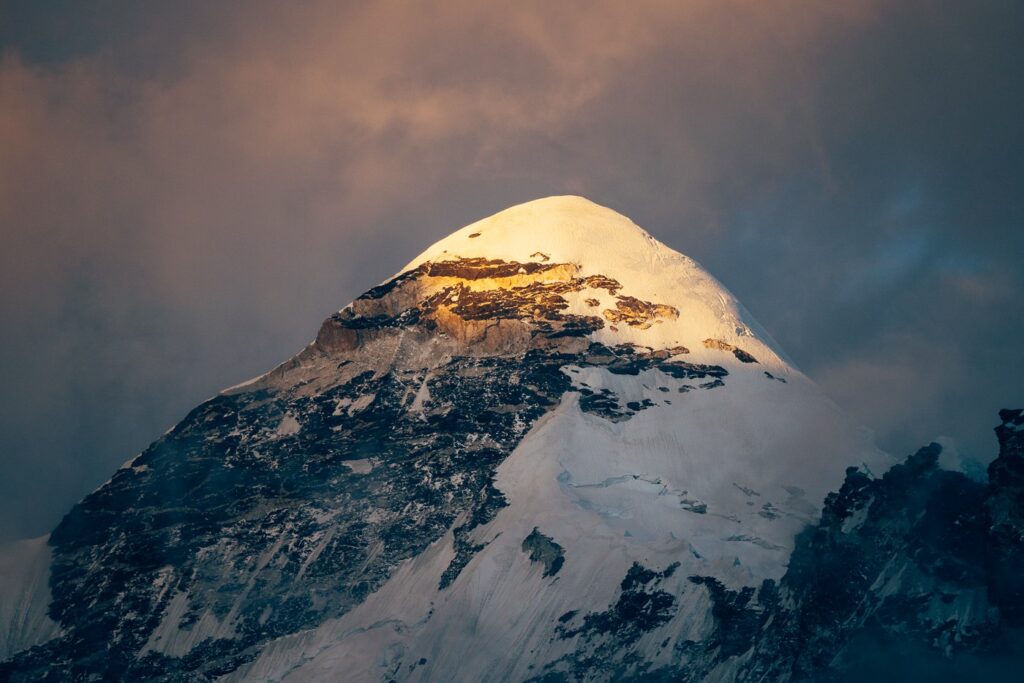
Day 9: Island Peak Summit Day
- Hike Distance: 5.8 km
- Hike Time: 10 - 14 hours
- Elevation: 1,100 m ascent, 1,100 m descent
- Sleep Altitude: 5,070 m
The Island Peak summit push from the base camp begins on the eastern side of the mountain before climbing the Northern ridge. The actual climb to the summit can be broken up into eight distinct sections:
- Island Peak Base Camp (5,087 m)
- Boulder field start (5,100 m)
- Island Peak High Camp (5,500 m)
- Crampon Point (5,800 m)
- Glacier traverse (5,800 m-5,900 m)
- Island Peak Headwall (5,900 m)
- Final Summit Ridge (6,100 m)
- Island Peak Summit (6,189 m)
Below I'll break down each section from my experience with photos to help you prepare.

Preparing for the Island Peak Summit Push
The day was finally upon us. Following a restless night in eager anticipation for the pursuit ahead of us, we woke for a rushed breakfast of porridge and boiled eggs in the shared mess tent.
Since this was a larger group, our expedition lead Chris decided to split us into two smaller units. This was organized based on climbing speed and experience, staggered an hour apart in hopes of catching up closer to the summit. This meant 4 Sherpa guides covering 11 climbers, an excellent ratio for summit success.
So, donning headlamps, harnesses, 6,000 m-8,000 m mountaineering boots, and bulky summit jackets, we set off in the cold, a full moon illuminating our path to the trailhead.

Boulder and Scree Climb to the Crampon Point
Beginning the Island Peak climb is a short, gentle stroll to the start of a dauntingly steep bouldered section.
As soon as we arrived, the climb was on. Did I mention that the section was steep– with an almost endless array of switchbacks climbing up the slope. Thankfully, the path through this section is well-worn, making navigation much easier.
After two hours, we arrived at Island Peak High Camp (5,500 m), which these days is not often used, with most expeditions climbing in a single day like ours. Although, there was one expedition tent mounted as we passed.
Passing the high camp, the boulders started becoming larger, requiring some light scrambling with three sections of short fixed ropes aiding the traverse. By no means is this section technical, but worth noting as it can drain the energy reserves for the big climb ahead.

Island Peak Crampon Point
After 4 hours, our team finally gained the crampon point, signified by the clearing of the boulder field and the day’s first light illuminating the frozen mountain backdrop.
Island Peak’s crampon point (5,800 m) is very beautiful, offering amazing views of the surrounding peaks with a huge glacial slab framing the foreground.


Since we’d layered down quite a bit following the steep climb, we immediately felt the crisp -15 degree celsius air clenching onto our bones. Safe to say, we rushed to fix our crampons onto our boots to avoid standing around too long in this inhospitable climate.
Immediately following this crampon point, we began traversing a steep, snowy section using fixed ropes and jumar. Our Sherpa guides also roped us together to prepare for the sea of ice glacier traverse ahead. The entire route from the crampon point to the summit is pre-set by the fixing team, so navigating is easy.

This was not long or technical, but definitely tiring at the higher altitudes. We noticed that some climbers from other groups were really struggling here.

Traversing Island Peak Glacier
Shortly after the climb, we were on the glacier of Island Peak. It’s important to note that glaciers are constantly moving and therefore the traverse and conditions will change every season. For us, we reached a narrow but deep crevasse requiring us to cross with the aid of a fixed aluminum ladder.
This was exciting for me as it was the first time I’d tried this technique.

Next, it was a short jumar push up yet another steep section before arriving at the snowy bowl-like plateau beneath Island Peak’s summit.
This section is mostly flat yet daunting as we stared at the near-vertical 200-meter wall to the summit ahead. It’s important to follow the worn track in this section, as branching off just a meter can lead to deep snowy holes or crevasses. Needless to say, we stuck close to our Sherpa guides.


The Final Summit Push
Reaching the wall is where the climb really begins. Apparently, this section can vary significantly in terms of technicality every season.
I’ve seen footage from this pitch covered in firm snow and ice for a largely untechnical jumar ascent. However, in April on our climb, the multi-pitch wall was a mix of messy rock and ice, requiring some strength to muscle our way up the face.

There was only one rope in most sections of the climb, meaning some time waiting for people to descend on the same line.
Luckily, there was not too much traffic on Island Peak during our ascent, but I could imagine that this would be frustrating and dangerous on high-traffic days on the mountain.

During the final headwall ascent, I remember thinking that this is by no means a simple trekking peak. Climbing rock and ice with crampons on a near-vertical pitch and swapping self-anchors and jumars between fixed lines certainly pertains a degree of technicality that beckons some degree of mountaineering experience. Luckily, the Sherpas do a great job at helping beginner climbers.

The loose rock and ice also meant ducking out of the way several times from falling debris sent down by other climbers.
Although very tiring, I really enjoyed this route and it definitely offered me some excellent mountain climbing experience.

After just shy of two hours, we gained the summit ridge of Island Peak. This is a snowy narrow ridge of about 50 meters leading up to the prayer flag-covered peak. Thanks to a fixed line leading straight to the summit, the final push is not technical although slightly tiring and certainly daunting for those uncomfortable with several vertical kilometer drops to the glacial valley beneath.

Island Peak Summit
Arriving at the summit was extremely rewarding and offered 360-degree panoramas of the Himalayan peaks including the summit and South Face of Lhotse (8,501 m), Nuptse (7,879 m), Lhotse Middle Peak (8,410 m), Lhotse Shar (8,383 m), Ama Dablam (6,812 m), Makalu (8,481 m), and Baruntse (7,162 m). While Mount Everest is very close, its summit is blocked by the towering South Face of Lhotse.
I stayed on the summit soaking in the views for roughly 15 minutes before beginning the grueling descent back to Island Peak base camp.



The Descent to Island Peak Base Camp
As with any climb, the biggest challenge is getting down the mountain safely.
The summit ridge was slightly congested on the way down, requiring some quick decoupling of safety lines to pass other climbers.
The following hour involved rappelling down the fixed lines to the plateau 200 meters below. I enjoyed this descent as I was comfortable with rappelling. However, as many climbers on Island Peak are first-timers, I can understand that this can be daunting. I watched a panicked climber drop his figure-eight belay device before being aided by a Sherpa guide.


Soon, we arrived at the snow bowl, where we waited for more of our other expedition members to join us for the final descent. It was clear that by now everybody was extremely tired, so we decided to descend together.

So, we crossed the snowy field, rappelled down the fixed lines, crossed the crevasse using the aluminum ladder, and finally reached the crampon point, where we removed the crampons and began the long, knee-busting descent down the scree and boulder field.

The final section descending the boulder field was very tiring, considering we’d been on the mountain for over 10 hours with little to no rest.
Passing high camp at just over 5,500 meters, our friendly guide Bagi met us with hot tea. This was a warm welcome and gave me some much-needed strength to walk down the 600 meters of endless scree switchbacks to camp.
Arriving Back at Island Peak Base Camp
Finally, after 13 hours, I arrived back at base camp, where my guide Sandip and cook Gyalzen Sherpa welcomed me with hot Sherpa Stew and tea. I quickly devoured this and my head quickly hit the inflatable pillow in the tent.
Thanks to the expert organization and planning of the Epic Backpacker Tours staff, and the professionalism of our Nepali and Sherpa guides, everybody returned safely to base camp and enjoyed a celebratory, yet tired dinner before a long sleep in our tent at base camp.

Day 10: Island Peak Base Camp to Dingboche
- Hike Distance: 11.2 km
- Hike Time: 3-4 hours
- Elevation: 50 m ascent, 800 m descent
- Sleep Altitude: 4,360 m
I woke up after a long, 12-hour sleep to the sound of Himalayan Snowcocks and busy Sherpas preparing a honey porridge breakfast. After meeting in our mess tent we packed our duffels in preparation for the easy descent back to Lukla.
It was a beautiful morning, with no wind and clear sunny skies. Our team was tired but in high spirits following the epic adventure we’d just had. Packing my duffel, I took some time to soak it all in and enjoy the precious, fleeting moments sitting beneath the Himalayan peaks, knowing the day prior I was standing atop one.

Below are some photos of the birds and a Himalayan mountain weasel I managed to photograph in the early morning around camp.




Once everybody was ready, we walked back down to Chhukung for lunch and tea. We also picked up some of our items left behind the days prior.
Next, it was an easy yet enjoyable walk back to Dingboche. Since we were ahead of time on our schedule, we changed lodges based on availability, staying instead at Paradise Mountain Lodge. I preferred this lodge, as it offered great views from the dining hall and large rooms with dedicated bathrooms.

Before dinner, I took some time lapses of the clouds rolling in over Ama Dablam above the village.
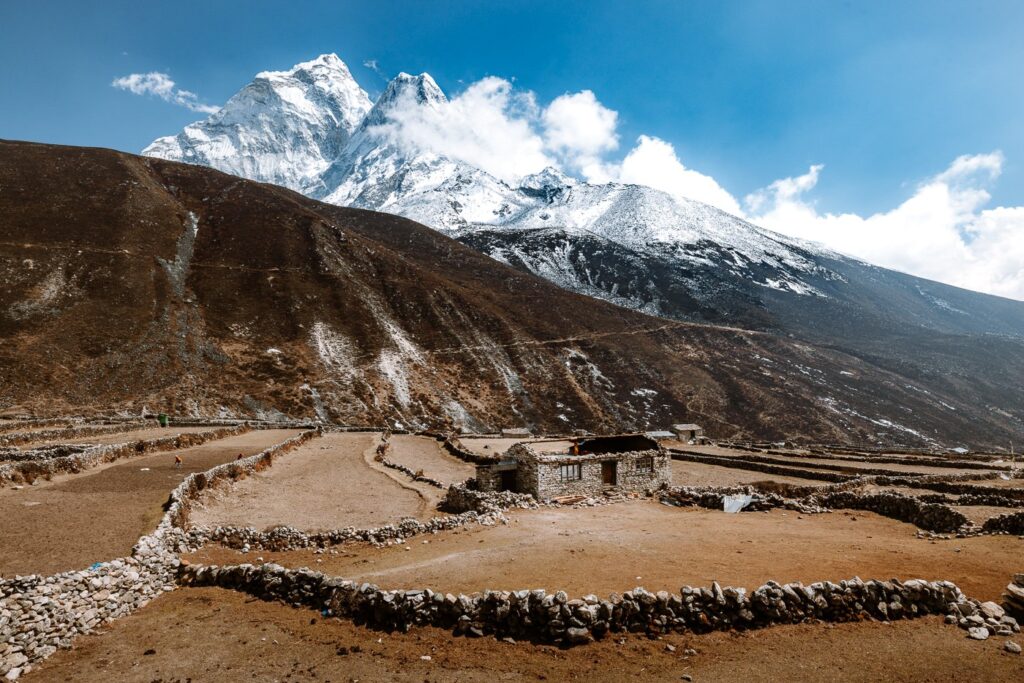
Day 11: Dingboche to Deboche (Diboche)
- Hike Distance: 11.2 km
- Hike Time: 3-4 hours
- Elevation: 90 m ascent, 640 m descent
- Sleep Altitude: 3,820 m
The plan on this original Island Peak itinerary was to hike back to Tengboche from Dingboche. However, as we were ahead of time and now approaching the peak of Everest Base Camp trekking season, availability for rooms on short notice is difficult to secure.
However, our experienced guides handled this for us, changing our plan to instead stay at Deboche (also written as Diboche), just 30 minutes before the small hill to Tengboche.
We departed just after breakfast, again enjoying a gentle, sloping route down the valley. We were quite shocked to see just how busy the trail was now that we were well into the April EBC trekking season. Honestly, it was a stark contrast compared to just a week prior.



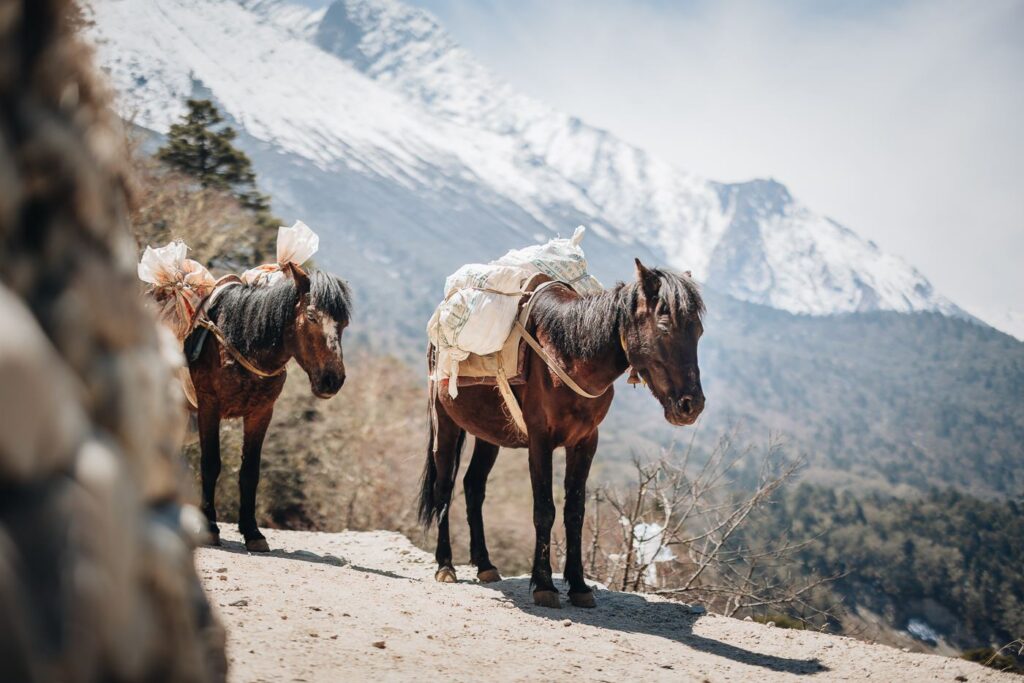
Nevertheless, the long, winding descent down to Deboche was very scenic, although dramatically different from the white, powdery scene we'd been immersed in on the way up.

Arriving at Deboche, we stayed at the huge Good Luck Lodge, which is run by the same owner as the Good Luck in Dingboche. This lodge was very comfortable and boasted a sizzling hot fireplace burner in the dining hall! At this stage of our Island Peak expedition, we were all very comfortable around each other and enjoyed a long night playing cards and cracking jokes.


Day 12: Deboche to Namche Bazaar
- Hike Distance: 11.6 km
- Hike Time: 3-4 hours
- Elevation: 560 m ascent, 915 m descent
- Sleep Altitude: 3,440 m
The following day, we trekked up the hill for 30 minutes to Tengboche, where we stopped at the Tashi Delek upstairs bakery for an espresso and baked good, while some members enjoyed a "Monk Special".

The rest of the day involved a sharp 600-meter descent back to the river, followed by a 500-meter ascent up the ridge. We stopped for a good two hours at a restaurant overlooking Ama Dablam just 1.5 hours from Namche, enjoying the last views of this amazing peak.

Arriving in Namche, most of us took advantage of the hot shower at the lodge, before spending a night playing pool at the Cafe Danphe Bar, my favorite watering hole in Namche Bazaar.



Day 13: Namche Bazaar Rest Day
Due to our successful early summit of Island Peak, our group decided to spend an extra night enjoying the mountain air in Namche Bazaar rather than turning back for Kathmandu early.
The day was spent relaxing in the sun, drinking coffee at the Sherpa Barista Bakery, and eating an epic wood-fired pizza at Basecamp cafe, followed by a Sherpa brewery beer back at Cafe Danphe Bar. Ahh, the wonders of Namche...


Day 14: Namche Bazaar to Lukla
- Hike Distance: 18.4 km
- Hike Time: 4-6 hours
- Elevation: 700 m ascent, 1,230 m descent
- Sleep Altitude: 2,610 m
A crisp, early rise on our final leg of the journey back from Island Peak involved the long march to Lukla. On the way up, we'd stayed in Phakding, breaking up the trek.
This time, we enjoyed the breezy hike down to the base of the valley, before the long, gentle climb back to Lukla.
Arriving in Lukla, our team celebrated with a jester's order of Russian salad before settling in for the night at The Nest Lodge.




Day 15: Lukla Flight to Kathmandu
Thanks to our awesome Nepali guide Sandip, we were greeted with the news that he'd managed to charter our return flight from Lukla to Kathmandu (Tribhuvan International Airport). This was welcome news as it meant that we didn't need to take the long 5-10 hour (yes it's unpredictable) minivan journey from Ramechhap.
Apparently, this is very rare in peak season but as with anything in Nepal, the important thing is who you know.
Arriving in Kathmandu, we checked in once again to my favorite hotel, Aloft Kathmandu, followed by a heartfelt farewell dinner. Many choose to stay in Kathmandu for a couple of days before taking their international flights out. This is a good idea as it'll give you enough time in case of delays.

Gear Requirements & Packing List for an Island Peak Expedition
Wondering what to pack for Island Peak? Below is a useful packing list with general gear requirements. If you're struggling to find good-quality mountaineering boots or summit-down jackets in your home country, you won't have a problem sourcing these things in Kathmandu.
For reference, I purchased all my (authentic) gear in Thamel at the official Marmot, Mountain Warehouse, and the North Face stores, which are all adjacent to each other on Tridevi Sadak near Himalayan Java Cafe. Otherwise, I've linked to the specific products that I use below (Amazon mostly). Americans can also find all of these at REI.

Personal & Trekking Gear
Below is what you'll want to bring with you for the trek to Island Peak Base Camp.
Trekking Gear
- Hiking boots
- 3-4x merino hiking socks
- 1-2x Trekking pants
- 1-2x Long sleeve trekking shirt
- 1x trekking shorts (optional)
- Fleece jacket layer
- Waterproof or Goretex shell
- Down or synthetic insulation jacket
- Hat & beanie
- Buff
- Sunglasses (preferably with side shades)
- Lightweight liner or trekking gloves
- Sunscreen
- Grayl GeoPress Water Bottle Filter
- Trekking poles
- Underwear
Tea House & Sleeping Gear
- 100-130L Duffel Bag (for porters)
- Daypack (30-50L)
- 17-°C/0°F Comfort-rated sleeping bag
- Sleeping bag liner (optional)
- Inflatable sleeping pad & pillow (optional)
- Merino base layers (top & bottom)
- Basic first aid kit
- Trail snacks
- Travel Towel
- Toiletries & toilet paper
- Multiple dry bags (for duffel contents)
- Headlamp with spare batteries
- Lightweight sandals or flip flops
- Earplugs
- Small repair kit

Gear for Island Peak Summit Push
Mountaineering & Climbing Gear
Summit Clothing
- 6,000 m or 8,000 m mountaineering boots like Scarpa Phantom 6000 or La Sportiva G2 Evo (I used my OLYMPUS MONS CUBE S 8000 m boots and they were fine)
- 1x Summit Socks
- Heavy down summit jacket
- Expedition mittens
- Balaclava (optional)
- Extra water bottle
An Ice Axe is not really necessary to climb Island Peak but many mountaineers might want to carry one for emergency self-arrest.


More Nepal & Himalayan Trekking & Climbing Guides
I hope that this comprehensive guide and detailed personal account of climbing Island Peak (Imja Tse) in Nepal has helped you prepare for this epic adventure.
Before you head off, check out some of my other blog posts below for more inspiration.
- Best Places to Visit in Kathmandu - discover 21+ unmissable highlights in Nepal's capital.
- Kathmandu Itinerary - how to spend 3 days in Nepal's capital.
- Everest Three Passes Trek - my guide to the ultimate Everest trekking experience!
- Manaslu Circuit Trek - get off the beaten path and discover the Himalayan region of Manaslu.
- Climbing Mera Peak - my experience climbing Mera Peak (6,476 m).
- Hotels in Kathmandu - read my helpful guide to where to stay in Kathmandu city.





